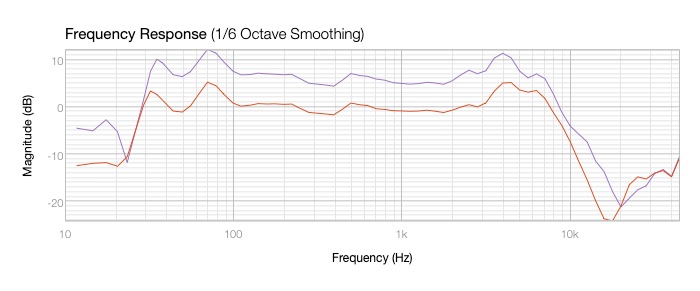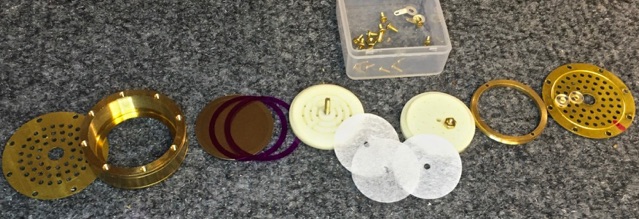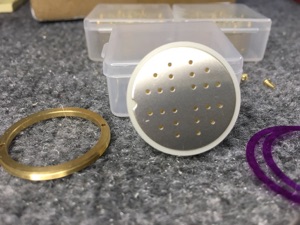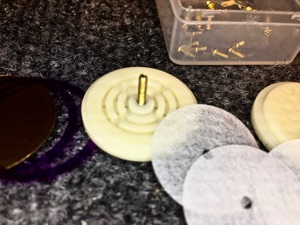Tinkering with a 34mm Electret Capsule

Can An Electret be improved?
Tuesday, March 8, 2022

Out of curiosity, I took one of the 34mm AliExpress “brass” electrets apart and tried changing some things to see what does what.
First experiment was taking off the front brass cover. No change. Removed the rear cover plate, and again there was no change in sensitivity or frequency response. The covers seem to be for appearance rather than having acoustic functions.
The next experiment was removing one of the red plastic spacers between the diaphragm and backplate. That should increase the capacitance and sensitivity, while reducing the loudest sound the capsule can handle. Sure enough, output for a given sound level went up by about 6dB. Half the spacing, double the output voltage. I didn’t test for maximum SPL. Neighbors might object.

1 Spacer Ring
2 Spacers
I hoped maybe the tighter spacing would increase damping and widen the extremes of frequency response, but that didn’t happen. Cardioid capacitor capsules’ diaphragms are tuned to the middle of the frequency band, then damping is added to reduce the peak and flatten response. These diaphragms are tuned rather low, and high frequency response falls rapidly above 7KHz. If I were using this mic for quiet sounds like bird calls, the added sensitivity would be welcome, but I’m not, so I put both spacers back in.
What else can we change? If we take the backplate and delay assembly apart, we see there are three main parts. The backplate has 24 small holes in it which connect to three concentric channels in the plastic delay assembly it’s pressed into. Behind that are three pieces of filter paper which form an acoustic resistance, and behind that is another thick plastic plate with holes through it which do not line up with holes in the backplate, forming an acoustic low pass filter.



What happens when we change the resistance part of the delay & filter assembly? Suppose we take out a piece of filter paper. That should reduce the damping a bit. Will it bring up highs above 7KHz? Remove two pieces of paper?

1 Piece of Paper
2 Pieces of Paper
OEM 3 Pieces of Paper
As layers of paper are removed, resistance is lessened and midband output rises, but the low and high frequency limits remain stubbornly the same.
If we take out all the paper, we get the diaphragm’s resonance as damped by air friction through the holes in the backplate only. The capsule is tuned to 550Hz, which is lower than most 34mm capsules, which textbooks say are typically tuned near 800 Hz, almost an octave higher.

I tried making a bump of Scotch tape in the middle of the backplate to touch and maybe stretch the diaphragm to see if that would raise the frequency, but the highs still cut off above 7KHz, and output dropped by 12dB.
By this point I’d run out of ideas, and taken the mic and capsule apart and put it back together so many times it’s a wonder it still works. So I put everything back together like it came from China. It still works, and measures within 1dB of where it started, so it’s a pretty rugged capsule. But the resonance is so low and the skirts of the peak so steep that minor tuning which can be done at home won’t come out better than the factory tuning.
On the other hand, I had a chance to experiment first hand with concepts I read about in books. These capsules are cheap enough that if a screwdriver slips and pokes a hole in the diaphragm, or some other disaster befalls, c’est la vie.
In conclusion, these capsules work well for voiceovers, but probably won’t be good on strings. They’re dark like vintage ribbons, rather than bright like most Chinese condensers but they have a presence rise before the drop off. I intend to try them as vocal mics and see how they compare to dynamics. Interesting stuff.

